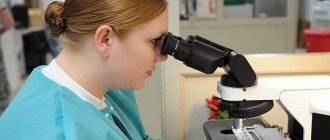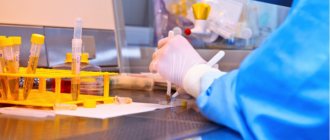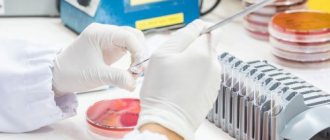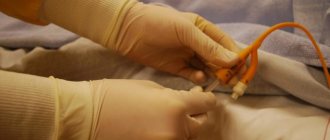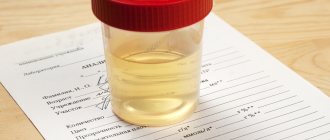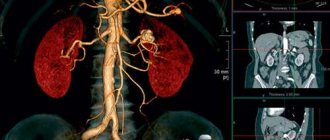The Amburger test is one of the methods for examining urine. Most often, patients who are suspected of having kidney disease - chronic pyelonephritis, glomerulonephritis - are sent for diagnostics.
Thanks to the Amburger test, it is possible to diagnose pathology at a very early stage.
This significantly facilitates treatment and improves the prognosis for recovery.
What is the Amburger test
The Amburger method is a urine test, the essence of which is to determine the number of blood cells in the collected sample.
This study determines the ratio of leukocytes and erythrocytes.
By quantifying blood cells, doctors can successfully diagnose many kidney diseases.
The analysis requires a special centrifuge. In it, blood cells are isolated using a special technique (they settle under the influence of centrifugal force).
Then, in a special chamber (for example, Goryaev’s chamber), the number of leukocytes and erythrocytes is counted.
Indicators of urine test results according to Amburge
Using the formula, you can count shaped cells.
The Amburger method allows you to count the number of formed blood cells in the urine according to the formula: A = Xx (1000 x V): (S x t), where:
- A - the number of formed plasma cells that are excreted in urine in 1 minute;
- X is the content of formed cells in 1 μl of sediment (the number of white and red blood cells is measured separately);
- 1000 - volume of dry sediment;
- V - total urine;
- S is the volume of substrate that was taken for centrifugation;
- t is the time during which the urine was collected.
Normal odds
| Coefficient | Norm in 1 minute |
| White blood cells | 2000—2500 |
| Red blood cells | 1000 |
Indications for the purpose of analysis
The Amburger method is very accurate, which allows you to diagnose problems with the genitourinary system at the earliest stages.
The main symptoms on the basis of which the doctor gives a referral for diagnosis include:
- Increased body temperature. A rise in temperature above normal often indicates the presence of some inflammatory processes in the body.
- Constant nausea.
- Vomit.
- Unpleasant sensations or pain in the lumbar region.
- Significant swelling of the extremities.
- Frequent urge to go to the toilet.
- During morning urination, the volume of urine is significantly less than usual.
These signs are enough to suspect diseases of the genitourinary system. The complex of diagnostic measures also includes the Amburger test.
Rules for preparing for material collection
In order to correctly collect urine for analysis using the Amburger method, the patient is required to perform a number of certain actions.
Preparation lasts for three days. This is important to achieve maximum accuracy of analysis results.
All the nuances of preparation will be explained by the attending physician, but the patient must clearly know the main points:
- The day before donating urine, the amount of fluid consumed should be reduced.
- Drinking is prohibited 12 hours before collecting biomaterial.
- You should not take diuretics, as this may distort the results obtained.
- Liquids that contain caffeine should be excluded from the diet. There is also a ban on intensely colored drinks such as juice.
- Drinking alcohol before taking the test is prohibited.
- The day before the test, you should stop eating spicy and salty foods.
- Women during menstruation should not take a sample, as the test result will be incorrect.
- Before collecting biomaterial, you should wash thoroughly.
- Urine is collected in a disposable sterile glass.
Improper preparation for a urine test according to Amburge can significantly distort the results and lead to an incorrect diagnosis.
Why sesame is useful for men: its effect on potency
Have you been trying to cure PROSTATITIS for many years?
Head of the Institute: “You will be amazed at how easy it is to cure prostatitis by taking it every day...
Read more "
Sesame for impotence has been used for a long time. Since ancient times, people have used these seeds to increase male strength. Indeed, with a decrease in potency, a man begins to feel insecure, and the point here is not only that the man in this case does not receive sufficient pleasure from all manifestations of life.
As potency decreases, a man begins to constantly think about it, which makes him more nervous, and this gradually turns into a vicious circle. Products containing a large amount of vitamin E can provide special assistance in solving this issue. And here sesame seeds can come to the aid of a man.
What are the beneficial properties of sesame that make it an important tool in enhancing potency and maintaining health in general?
Composition of sesame
Sesame contains the following beneficial substances that have a beneficial effect on the human body:
- Copper, contained in large quantities in sesame seeds, has a strengthening effect on bones and joints, as well as blood vessels. Copper reduces the intensity of swelling and pain.
- Magnesium supports the nervous system and helps reduce blood pressure.
- The calcium in sesame can help prevent colon cancer, osteoporosis and migraines.
- Zinc also helps maintain bone health.
- The large amount of protein in sesame seeds promotes rapid recovery of the body after increased stress and provides food for muscle growth.
- The phytosterols contained in sesame seeds lower cholesterol levels, which helps keep blood vessels clean, improve blood circulation and increase potency.
The benefits of sesame for men
Sesame is a real godsend for men, because the substances it contains significantly affect potency. The benefits of sesame for men were known already in ancient times; since then, many recipes have been preserved that increase male libido, which included sesame seeds.
The nutritional value of sesame seeds is high. It is most widely used in many eastern countries. The content of a large amount of vitamin E in sesame gives the opportunity and every right to say that sesame for potency is one of the indispensable products. The vitamin of youth also prolongs the sexual activity of the male population and allows for improved erection.
Sesame and potency are two inseparable concepts. To increase activity, it is recommended to eat a sufficient amount of sesame seeds. The oil obtained from sesame seeds and called tahini, is similar in composition to meat and is a worthy substitute.
When consuming sesame seeds in combination with honey, the effect of sesame increases many times over, because honey is also a powerful stimulant of male power due to its high content of biologically active substances.
Halva, prepared from sesame seeds and natural honey, is an excellent aphrodisiac. Sesame seeds are also used as a spice and to add a special taste to prepared dishes.
An interesting recommendation is to take a mixture of seeds of the following plants in equal proportions:
- Flax.
- Sesame.
- Maca.
The mixture of these seeds has a pronounced stimulating property and is recommended as an aphrodisiac for both men and women.
Previously, women who cared about their sexual sphere regularly took a spoonful of sesame seeds on an empty stomach, chewing them thoroughly. The high calcium content makes it possible to use sesame to form a strong skeleton of the unborn child. Sesame seeds also prevent the development and occurrence of cancer thanks to vitamin E.
Knowing about such a variety of beneficial properties of sesame seeds, try to please your homemade buns and crackers with sesame sprinkles as often as possible, and also use sesame in food to improve sexual health and prolong youth.
IT IS IMPORTANT TO KNOW! D. Pushkar told how to defeat prostatitis at home...
Such a pleasant treatment for prostatitis for 147 rubles...
Health and longevity to you!
It has been established that human kidney nephrons have a unique ability to survive. Even in the event of the death of one part, the other compensates for their lost function until restoration. Therefore, treatment of renal failure must be carried out at any stage.
The developed treatment methods include a scheme of emergency necessary measures for the acute form of the disease and an impact on the pathogenetic mechanisms of impaired kidney function. The choice of how to treat renal failure is based on the results of an examination of the patient, determining the degree of loss of function, and the reserve of the paired organ when only one kidney is affected.
The doctor is obliged to think about the nephrotoxicity of each prescribed drug, the special sensitivity of the body, and the participation of other organs in the overall picture of the disease. Let us consider approaches and methods of treating acute and chronic forms of insufficiency separately.
Treatment for shock
Acute kidney failure in 90% of cases is a consequence of a sharp drop in blood pressure during shock. Therefore, targeted protective therapy of the kidneys is necessarily involved in the scheme for removing the patient from shock.
To replenish the volume of blood loss, use:
- plasma;
- Reopoliglyukin;
- protein solutions.
The patient's central venous pressure is simultaneously measured. It is important not to “overfill” the amount of liquid; you cannot exceed +10 cm of water. Art. This may cause pulmonary edema.
During operations on the heart and large vessels, in order to prevent kidney damage, the following is administered:
- Mannitol solution - is able to maintain blood circulation in the kidneys and prevent the formation of cylinders in the tubules;
- loop diuretics (Furosemide) have a similar effect.
Even in emergency conditions, the administration of these drugs should be stopped if an increase in urine output cannot be achieved and the concentration of creatinine in the blood serum increases.
What is the treatment for acute kidney failure that has already developed?
In the presence of acute renal failure, medications must ensure resistance to all threatened consequences of damage to the body:
- water retention in cells (hyperhydration);
- hyperkalemia (increased potassium concentration in the blood);
- uremia (accumulation of nitrogenous waste, determined by the level of urea and creatinine);
- anemia (drop of red blood cells);
- disturbed electrolyte balance;
- acidosis (deviation of acid-base balance to the acidic side);
- addition of infection.
For moderately severe deficiency, conservative treatment is used.
Water regime - the total volume of fluid administered should replenish losses through urine, vomiting, diarrhea + have a reserve of 400 ml. Control is carried out by weighing the patient daily. It is better if the liquid comes with drinking water.
The following rules should be followed:
- an increase in the patient’s temperature for each degree above 37 requires 500 ml more fluid;
- for shortness of breath with a respiratory rate of 10 more than 20 per minute, another 400 ml of water is added.
Intravenous solutions help provide the required volume. In the presence of reduced plasma sodium concentrations, overhydration will require fluid restriction.
To avoid hyperkalemia in a patient with an operated kidney, timely treatment of the wound, removal of necrotic tissue, and drainage of cavities is necessary. Foods containing potassium are limited in the diet.
You can learn more about nutritional problems in kidney failure in this article.
To reduce the breakdown of protein compounds, anabolic steroids are prescribed and infection prevention is carried out. The patient's diet should be protein-free, but the calorie content of food should be within the range of 1500–2000 kcal/day. In cases of persistent vomiting, parenteral intravenous nutrition is provided with glucose solutions, amino acid mixtures, and Intralipid.
It should be taken into account that antibiotics in conditions of cessation of kidney function and increased vascular permeability become more toxic. It has been shown that even relatively low-toxic drugs of the penicillin series and cephalosporins cause hemorrhagic complications (bleeding) in patients due to an increased effect on platelet adhesion and prothrombin levels. Therefore, the prescription of these drugs for renal failure should be strictly dosed in accordance with the severity of the renal pathology.
How does therapy depend on the level of kidney damage?
The attending physician must clearly understand the cause of renal failure. As you know, 3 types of acute disorders are possible:
- prerenal;
- postrenal;
- renal
Prerenal insufficiency is regarded as a secondary phenomenon and is associated with circulatory disorders. Treatment requires restoration of renal blood flow. If there is a significant loss of fluid, compensation and therapy for hypovolemia will be required.
Prescribing standard medications without taking into account the root cause can worsen the severity of the patient’s condition:
- diuretics such as saluretics, with hypovolemia lead to a vicious circle during insufficiency;
- in the case of small output syndrome in the presence of heart failure, copious administration of solutions is contraindicated.
For postrenal oliguria, intensive therapy is carried out against the background of instrumental or surgical intervention in urological surgical hospitals. Through catheterization and puncture of the pelvis, it is necessary to ensure the outflow of urine through the urinary tract.
Uremia creates a high risk of developing an infectious process in the kidney tissue. Widespread infection is the direct cause of mortality in 1/3 of patients with postrenal insufficiency in the postoperative period. Most often, the infectious process develops in the trachea and bronchi and affects the urinary tract.
For antibacterial therapy it is advisable to use:
- combinations of Metronidazole and third-generation cephalosporin antibiotics (Claforan, Ceftriaxone, Fortum, Longacef);
- in severe sepsis with shock, therapy with Tienam (Meronem) is indicated.
Aminoglycosides are strictly contraindicated due to their high nephrotoxicity.
When is hemodialysis performed?
The question of the need for dialysis therapy is decided in the absence of effect from conservative treatment of acute kidney failure and an increase in the content of nitrogenous compounds in the blood.
Hemodialysis is indicated for:
- exceeding the potassium threshold concentration of 7 mmol/l;
- state of oligoanuria for five days or more;
- developing pulmonary or cerebral edema;
- pronounced uremia and acidosis.
The procedures are carried out daily or once every 2 days, while the amount of protein consumed from food and the volume of liquid drunk increases. In treatment practice, methods of slow but constant blood purification using hemofiltration and hemodiafiltration are used.
The use of an “artificial kidney” is contraindicated if there are:
- decompensation of hypovolemia;
- presence of internal bleeding;
- cerebral hemorrhage.
Using detoxification methods
Hemofiltration is a technique for removing intoxication, which involves removing more than 20 liters of water while simultaneously replacing it with polyionic solutions containing the necessary set of electrolytes. It is believed that this method is more physiological, since filtration membranes and pressure close to the renal glomeruli are used. Effectively removes substances with medium molecular sizes from the body, better improves gas exchange in the lungs.
Plasmapheresis is used as one of the components of dialysis. In the treatment of acute renal failure the following is manifested:
- direct removal of toxic substances from plasma;
- removal of excess fluid from the vascular bed.
It is considered especially effective in the phase of relieving oligoanuria (before hemodialysis) for an additional opportunity to increase the amount of fluid administered and remove nephrotoxic and hemolytic poisons. Plasmapheresis is especially indicated:
- patients with myeloma, thrombocytopenic purpura, complicated by acute renal failure;
- with DIC syndrome;
- patients with rapidly progressing glomerulonephritis.
The enterosorption method involves the use of tablets or powder, which, when they enter the intestines, collect toxic substances, metabolic products, and nitrogenous wastes. An example of a drug from the group of sorbents is Enterosgel. It has practically no contraindications. Used by the course to enhance other techniques during the period of oligoanuria.
How is renal insufficiency treated?
Renal (intrarenal) damage involves the use of any method of reducing the degree of destruction of the renal epithelium in countermeasures. At the beginning of treatment it is necessary:
- restore blood circulation in the arterial system and microcirculation in the tissue; for this, a combination of Reopoliglucin with Pentoxifylline is recommended;
- stop administering nephrotoxic drugs to the patient;
- establish control over the content of nitrogenous waste and electrolytes in the blood, the specific gravity and acidity of urine.
To use the reserve capabilities of the kidneys, it is necessary to stimulate the function of working nephrons with the help of:
- antispasmodics (Eufillin, Papaverine are administered 6–12 times a day, combination with a small dose of Dopamine is allowed);
- alkalizing agents (sodium bicarbonate solution intravenously);
- loop diuretics (diuretics) - Lasix, Furosemide.
To combat hyperkalemia, the following are used:
- Amburge mixture intravenously (composed of 40% glucose solution, insulin, calcium chloride);
- repeated administration of calcium gluconate 2-3 times with a break of 5 minutes while monitoring the ECG;
- administration of sodium bicarbonate;
- taking ion exchange resins;
- stimulation of diuresis.
Therapy is carried out for six hours in anticipation of the transition of potassium into the cellular space.
Basic principles of treatment of chronic kidney failure
Let's consider the treatment of chronic renal failure depending on the participation of various factors of damage.
Features of treatment of the underlying disease
In the pathogenesis of the chronic form, the main role is played by long-term diseases, ultimately leading to kidney failure. Therefore, in treatment it is necessary to achieve improvement or stable remission of diseases such as:
- urolithiasis;
- glomerulonephritis;
- diabetic nephropathy;
- polycystic kidney disease;
- hypertension.
A feature of their therapy is the desire to avoid the toxic effect of drugs on already reduced kidney function. This should be taken into account when choosing:
- cytostatics for glomerulonephritis;
- antibiotics for urinary infections;
- diuretics for hypertension.
Ensuring protection of renal reserve
In order to prevent irreversible progressive changes in the kidneys, it is necessary to pay attention to counteracting:
- intraglomerular hypertension;
- hyperfiltration;
- development of systemic arterial hypertension.
For this purpose:
- angiotensin-2 receptor blockers;
- ACE inhibitors;
- low protein diet;
- antihypertensive drugs.
The role of ACE inhibitors is:
- providing a hypotensive effect through inhibition of the synthesis of angiotensin-2 as a powerful vasoconstrictor;
- reducing hypertension inside the glomeruli, eliminating hyperfiltration by dilating arterioles;
- inhibition of parenchyma sclerosis by influencing the processes of cell proliferation and collagen synthesis;
- reducing protein loss in urine.
The effect of drugs increases in case of restriction of salt in food and combined action with diuretics. Angiotensin-2 receptor blockers have similar properties.
The dose of drugs is selected individually based on the results of systematic monitoring of the level of creatinine and potassium in the blood. ACE inhibitors are not indicated:
- in the terminal stage of the disease;
- with hyperkalemia;
- in cases of bilateral narrowing of the renal arteries;
- pregnant women.
A low-protein diet slows down the rate of development of renal failure by reducing the formation of internal toxic substances from breakdown products and restoring intraglomerular hemodynamics.
Treatment of high blood pressure of renal origin
The use of medications for impaired renal function is limited to vital drugs. Hypertension must be treated. High blood pressure contributes to the development of nephrosclerosis.
It should be remembered that patients with kidney damage are contraindicated:
- thiazide diuretics (Hypothiazide);
- a group of potassium-sparing diuretics (Veroshpiron, Triampur).
It is less often recommended to use Clonidine, Dopegit.
The most acceptable combinations:
- ACE inhibitor + Furosemide + blocker;
- calcium antagonist + β-blocker + sympatholytic, taking into account the mandatory restriction of salt in food.
There is ongoing debate among nephrologists and cardiologists regarding the required level of reduction in blood pressure numbers:
- some argue for the need to bring it to a normal level;
- others point to known cases of failure of the compensatory mechanisms of the kidneys with a significant decrease in pressure.
Symptomatic treatment
Symptoms do not manifest themselves in the same way, so the means of correction have an individual choice.
- To eliminate anemia, drugs containing erythropoietin are prescribed.
- For the purpose of detoxification, courses of enterosorbents (Enterosgel, Polyphepan) are indicated.
- As acidosis increases, a soda solution is administered intravenously.
- If the patient is bothered by painful cramps in the muscles of the legs, this indicates a decrease in calcium in the blood. Calcium forte and calcium carbonate are used for compensation.
- Chronic patients often develop hyperfunction of the parathyroid glands, which requires the use of vitamin D or surgical removal of the glands.
What drugs are not recommended for use in treatment?
In the treatment of renal failure, drugs with nephrotoxic effects and aggravating metabolic disorders are contraindicated. These include:
- antibiotics - aminoglycosides, tetracyclines;
- X-ray contrast agents;
- non-steroidal anti-inflammatory drugs;
- potassium preparations;
- thiazide and potassium-sparing diuretics;
- ACE inhibitors in inappropriately large doses;
- protein preparations (except for special nephrological and emergency indications).
What plants can be used for folk remedies?
Treatment of renal failure with folk remedies does not have an evidence base for effectiveness. In practice, information exists at the advertising level. We can confidently say that there is no herb with healing properties that restores dead kidney tissue.
Urologists recommend herbal decoctions and preparations during the recovery stage after acute kidney failure. They are also suitable for chronics to prevent kidney infections. Doctors offer plants with anti-inflammatory and disinfectant effects on the urinary tract. These include herbal infusions from:
- sequences;
- lingonberry leaves;
- dandelion and calendula;
- lemon balm;
- coltsfoot;
- chamomile and violet flowers;
- dill seeds;
- mint;
- St. John's wort;
- bay leaf;
- bearberry;
- rose hips and hawthorn fruits;
- parsley root.
It must be taken in the form of a decoction. Count the liquid you drink in the total volume. The patient may have diseases that have contraindications to herbal treatment. Therefore, you should consult your doctor.
Every year new drugs and methods for the treatment of renal failure appear. Effectiveness depends on the severity of the underlying disease. Any renal pathology requires careful attention to therapy and compliance with preventive measures.
How to collect material
After preliminary preparation, you can begin the process of collecting biomaterial.
The algorithm for collecting biomaterial for urine analysis according to Amburge is quite simple:
- During the morning visit to the toilet, the patient should completely empty the bladder. Even a small amount of urine remaining in the organ can distort the result.
- It is important to record the time of urination.
- It is forbidden to go to the toilet for three hours.
- After this, you need to collect the urine in a container for analysis. You need to wash yourself well first.
During the waiting period between the start of the analysis and the urine collection itself, there are no restrictions on food and water intake.
The rules for collecting urine are simple. Their careful observance will allow you to obtain the most reliable results.
Conducting research
The Amburger method is a rather complex study. To carry out this, the laboratory assistant needs:
- a measuring tube designed for use in a centrifuge;
- pipette 10 ml;
- counting chamber;
- glass rod;
- microscope;
- centrifuge.
The study itself is carried out as follows:
- Urine collected for analysis using the Amburger method is submitted to a diagnostic laboratory.
- The biomaterial is transferred to a special centrifuge tube.
- Urine is divided into fractions by centrifugation for 5 minutes.
- The height of the upper fraction must be at least 1 cm. It is drained as unnecessary.
- Repeated centrifugation of the sediment at a speed of 2000 rpm.
- Remove the top fraction again.
- In the resulting material (pre-mixed), the number of leukocytes and erythrocytes is counted. To do this, use a counting chamber.
Based on the results obtained, the doctor makes a conclusion about the presence or absence of the disease.
Results: norm and deviations
As a result of urine analysis using the Amburger method, information is obtained on the quantitative content of leukocytes and erythrocytes. In order to interpret these values, they are compared with a conventionally accepted standard.
Scientists have accepted that the standard showing the complete absence of disorders in the genitourinary system is the following indicators:
- leukocytes – 2000 pcs.;
- red blood cells – 1000 pcs.
Deviation of no more than 10% is allowed.
If, when interpreting the tests, a significant discrepancy with normal values is revealed, the presence of some kind of disease can be assumed.
To understand the results of the study, it is important to know what role white blood cells and red blood cells play in the human body, and under what conditions their number can increase and decrease.
- Leukocytes. Their increased content indicates inflammatory processes occurring in the organs of the urinary system. In addition, their increase is possible after injury or surgery.
- Red blood cells. Their excess quantity indicates that pathological processes are occurring in the human body that require urgent medical intervention.
The main reasons for possible deviations include the following pathologies:
- Pyelonephritis. Infectious and inflammatory lesions of the renal pelvis and calyces. With this pathology, an increased number of leukocytes will be observed in the urine sample. The erythrocyte count is normal.
- Glomerulonephritis. An autoimmune disease that affects the glomeruli. When analyzing the analysis using the Amburger method, a significant excess of red blood cells will be detected in patients suffering from this pathology. The number of leukocytes is normal.
- Cystitis. Inflammatory disease of the bladder. With it, an increase in the content of leukocytes in the urine is observed.
- A variety of purulent-inflammatory processes occurring in the kidneys. The urine contains a significant number of leukocytes.
If the result of the Amburger test shows a reduced number of both leukocytes and erythrocytes, the sample is considered unreliable. Repetition of the analysis is required.
DSP compositions
Ordinary sand cement is made from the following components:
- Factory cement.
- Fine sand. It is pre-cleaned from foreign impurities.
- Modifiers in accordance with GOST for DSP, helping to improve the quality of the finished mixture.
- Water, which will make the solution more viscous and plastic. It also regulates the density of the DSP.
The entire composition of the cement-sand mixture must be vigorously mixed so that the components can be evenly distributed. Manufacturers allow the addition of dyes to the mixture. The admixture of fiber with a reinforcing function is also not prohibited.
The characteristics of the DSP depend on the amount of ingredients being mixed. However, their proportion may vary depending on the purpose of the mixture:
- Scope of application of the composition. Sometimes you need a thicker, richer mixture.
- Brand of Portland cement. Using good cement, you will make a high quality mortar.
- Proportion of binder. Please note that during prolonged storage the material will lose its primary characteristics.
- Moisture concentration in base raw materials. If the humidity is increased, then the amount of water should be reduced.
Advantages and disadvantages of the Amburger method
The Amburge urine test cannot be called an ideal diagnostic method. It has both its strengths and weaknesses.
The main advantages of the method include:
- High research accuracy.
- High sensitivity to changes in the number of leukocytes and erythrocytes. This allows the disease to be diagnosed even at an early stage.
- Most available in outpatient settings.
The analysis allows you to diagnose kidney disease and, accordingly, begin the correct treatment in a timely manner.
Among the disadvantages it should be noted:
- Limiting fluid intake during preparation for analysis.
- For some patients, the condition of not going to the toilet for three hours is impossible.
- In some cases, the patient has great difficulty complying with the requirement to completely empty the bladder. For example, with diseases such as adenoma and prostate cancer, this condition is practically impossible to fulfill.
- If one kidney is affected, the Amburger method will give an incorrect result. Since urine is produced by both organs, the number of leukocytes and red blood cells is the average result of the work of the two kidneys. Accordingly, the severity of the disease is incorrectly assessed, and time will be lost.
Also, this method is not available for bedridden patients.
Collection rules
An integral part of any medical study is the preparation stage, on which the quality of the results obtained depends (for example, in the absence of a toilet for the genital organs, distortions in the true number of leukocytes are possible).
The purpose of this test is determined by the attending physician. He is also authorized to explain the essence of the study and give the patient instructions for preparing for urine collection. The day before the study, the patient needs to limit fluid intake during the day and completely eliminate it at night.
In the morning, you need to carry out hygienic treatment of the external genitalia and empty the bladder (this is done physiologically or by inserting a catheter into it), note the time and collect urine for examination in a clean jar for 3 hours.


